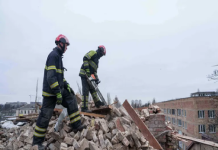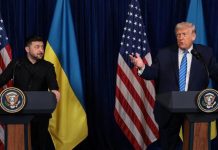DUBAI, United Arab Emirates (AP) – The head of the UN’s nuclear watchdog met with Iranian officials on Saturday. Days after it was revealed that the country had enriched uranium particles to near-weapons levels, it sounded new alarm bells about the long-controversial serial nuclear arsenal.
The head of the International Atomic Energy Agency, Rafael Mariano Grossi, at a press conference with the head of Iran’s nuclear program said the delegation’s work was not yet completed and declined to comment on his talks.
“It’s an atmosphere of work, integrity and cooperation,” Grossi said. He was later scheduled to meet with Iranian President Ebrahim Raisi and speak to reporters after returning to Vienna.
Earlier this week, the Vienna-based International Atomic Energy Agency reported that uranium particles enriched to 83.7% — just below weapon class — were found at Iran’s underground He Fordow nuclear facility.
The IAEA’s confidential quarterly report, distributed to member states on Tuesday, comes amid Western anger over months of anti-government protests in Iran and the export of attack drones to Russian forces fighting in Ukraine. , announced at a time when tensions were already high.
The IAEA reports that his two cascades of IR-6 centrifuges at his Fordow facility in Iran are configured in a “substantially different” manner than previously described. He was discovered in January by investigators. The IAEA took samples the next day and showed particles up to 83.7% pure, the report said.
The IAEA report only mentions “particulate matter”, suggesting that Iran does not stockpile uranium enriched above 60% of hers. However, the agency said in its report that it “will continue to increase the frequency and intensity of its review activities” at Ford following this finding. Iran has attempted to portray the detection of highly enriched uranium particles as a temporary side effect of trying to achieve a final product of 60% purity. But experts say wide variations in purity, even at the atomic level, would raise suspicions among inspectors.
Mohammad Eslami, head of Iran’s nuclear program, confirmed the findings of the IAEA report at a press conference with Grossi, but said it was not 84% enriched. ‘ said it was resolved.
A non-proliferation expert says Tehran has no civilian use of uranium he has enriched to 60%. A stockpile of 90% enriched material, the level required for a nuclear weapon, could be readily used to create a nuclear bomb if Iran so desired.
Her 2015 nuclear deal with Iran and world powers limited Tehran’s uranium supplies, limiting her enrichment to 3.67%. This is enough to run a nuclear power plant.
After the US unilaterally withdrew from her 2018 deal and reimposed crippling sanctions on Iran, it began openly violating the pact’s restrictions. Efforts by the Biden administration, European nations and Iran to negotiate a return to the deal stalled last summer.
Although Iran has long denied seeking nuclear weapons and claims its program is peaceful, it is widely believed to have had a nuclear weapons program until 2003. Grossi last visited Iran in March 2022.






